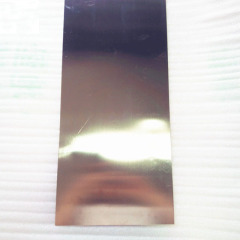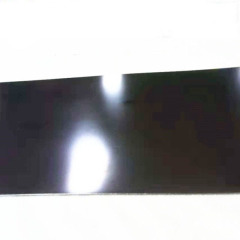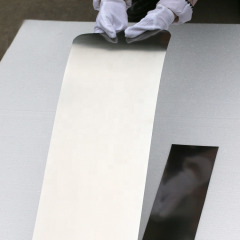



ASTM F2063 0.2mm Thickness Nitinol Shape Memory Alloy Sheet
| Min. Order: | 15 Kilogram |
|---|---|
| Payment Terms: | WU |
| Place of Origin: | Jiangsu |
Company Profile
| Location: | Changzhou, Jiangsu, China (Mainland) |
|---|---|
| Business Type: | Manufacturer |
| Main Products: | Thermal Spray Wire |
Product Detail
| Width: | ≤300mm |
|---|---|
| Density: | 6.45g\Cm |
| Af: | -20~100ºC |
| Feature: | Superelastic and Shape Memory |
Product Description
Nitinol Sheet, Foil and Ribbon are the newest and most exciting product forms for this unique shape memory alloy. Nitinol sheet is ideal for laser cutting, etching, stamping and EDM machining. Efficient processing and surface finishing establishes a smooth, light oxide surface.
Many new medical innovations are now possible with the use of this very thin and versatile Nitinol form. Sheet is a two-dimensional structure, unlike wire and tube, giving us design options like stamping, punching, and deep drawing.
Dimension | Thickness ≥ 0.1 mm, Width ≤ 200 mm |
Alloys | NiTi, Cu NiTi, Fe NiTi |
Features | Superelastic and Shape Memory available. |
Temperature Range ( Af ) | - 20 ~ 100 deg. C |
Surface | Natural Oxide, Pickled/Etched and Customer Specific Requirements |
Thermomechanical Conditions | As Cold-Worked, Straight Strain Annealed and Shape Set Annealed. |
Certification | Transformed Temperatures, Tensile Properties, Chemical Composition and Customer Specific Requirements |
Application of Nitinol Sheet & Foil
Nitinol sheet is ideal for laser cutting, etching, stamping and EDM machining. Efficient processing and surface finishing establishes a smooth, light oxide surface.
Many new medical innovations are now possible with the use of this very thin and versatile Nitinol form. Sheet is a two-dimensional structure, unlike wire and tube, giving us design options like stamping, punching, and deep drawing. JM will work with you to fabricate Nitinol sheet to your specifications, with sheet as thin as 0.002"
| Products | Grade | Transformation Temperature AF | Form | |
Shape Memory Nitinol Alloy | Ti-Ni-01 | 20 °C~ 40 °C | Wire,bar,plate | Customer Specified or Industry standard |
Ti-Ni-02 | 45 °C~ 90 °C | Wire,bar,plate | ||
Superelastic Nitinol Alloy | TiNi-SS | -5 °C~ 5 °C | Wire,bar,plate | |
Low Temperature Superelastic Nitinol Alloy | TN3 | -20°C~-30°C | Wire,bar,plate | |
TNC | ||||
Medical Nitinol Alloy | TiNi-SS | 33 ± 3 °C | Wire,bar,plate | ASTM F2063 |
Narrow Hysteresis Nitinol Alloy | Ti-Ni-Cu | As-Ms ≤ 5 °C | Wire,bar | |
Wide Hysteresis Nitinol Alloy | Ti-Ni-Fe | As-Ms ≤ 150 °C | Wire, bar |
| Alloy | Chemical composition | AF point | Min elongation (%) | Max Residual elongation after 6% strain | Application | Standard |
NiTi | 55.6-55.8wt%Ni | Body Temperature 20ºC-40ºC | 15 | 0.1 | Orthotic Arches | ASTM F2063 |
Superelastic Nitinol
This product form takes advantage of the stress-induced martensitic transformation to achieve incredible amounts of flexibility, strain recovery, and kink resistance. Nitinol behaves superelastically if the Active A(f) temperature is below its use temperature. Applications that are intended to be superelastic at room temperature are generally produced with an Active A(f) temperatures below room temperature in the range of 0 C to 20 C. A superelastic material will remain superelastic up to a temperature from the Active A(f) to a temperature about 50 C above Active A(f). Therefore a material with an Active A(f) of about 15 C will exhibit good superelasticity up to about 65 C. Please contact Seabird for more information regarding the use of Alloys.
Shape Memory Nitinol
This product form exhibits the ability to recover a shape upon heating above Active A(f). Therefore, the most critical property to specify is the Active A(f). This represents the finish of the transformation from martensite to austenite upon heating, and therefore the temperature at which the shape recovery is also complete. The start of the transformation upon heating is the Austenite Start Temperature, A(s), and is about 15 C to 20 C lower than the Active A(f).
Upon cooling, there are comparable start and finish transformation temperatures for the reverse transformation from austenite to martensite. These are known as M(s) and M(f), respectively. The M(f) temperature is about 15 C to 20 C lower than M(s). There is a hysteresis in the transformation, meaning that the transformation to martensite upon cooling is below the temperature at which the martensite reverts to austenite upon heating. For binary shape memory materials, the difference between M(p) and A(p) is 25 C to 50 C. There is a peak in the transformations from austenite to martensite, and martensite to austenite, and this information is captured as A(p) and M(p) temperatures during DSC testing per ASTM F2004.
Advantages
More than 16 years experience in the processing of nitnol products.
The complete production line makes us control the quality from beginning to finishing.
We have excellent research team that 5 engineers can always supply the exact solution for you.
The testing items we do covering all properties you like.
Customized sizes are available.
- Packaging & Shipping
- According to conditions of the goods, we supply below packaging and shipping:
Steel Pallet + Plywood Case + Plastic/ Moistureproof Paper
Fumigated Wooden Pallet
Plywood Case + Plastic/ Moistureproof Paper
Plywood Case + Vacuumed Plastic Bag
Carton + (Vacuumed) Plastic Bag
Transport by sea (Large Quantity)
Transport by air (Urgent Indent )
Transport by train (Asia and East Europe)
Transport by land (Russia, Middle Asia)
Transport by Express (FedEx, DHL, TNT, UPS etc.)

